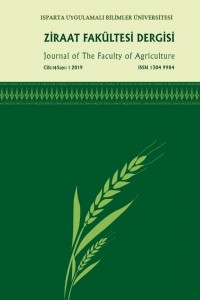Comparative analysis of the influence of different doses of vegetal bio stimulator on agricultural productions
Abstract
The paper shows how an experimental bio stimulator
derived from agricultural waste and herbs can help the roots absorption of
mineral elements and quality of agricultural products. The cultures that were
tested the experimental bio stimulator were wheat, barley, rape, maize,
sunflower, soybean. The main product of the project (BIOSTIM) that was tested
had the following composition: N - 4.1 g / l; P2O5 - 6g /
l; K2O - 14g / l; Ca - 8 g / l; Mg - 1 g / l; Fe - 61,5mg / l; Mn -
50mg / l; Zn - 7,6mg / l; vegetal antibiotics; amino acids. Four doses were
used, ranging from 0.5 l / ha and 2L / ha, in two and three treatments, on the
intense development stage to flowering, in comparison with the untreated
control. The results of chemical analyzes of soil and plant extracts, could
follow the evolution of absorption of mineral elements in correlation with the
biometric measurements and productivity elements. The results of experiments
showed highly significant positive correlation between bio stimulator dose,
intensity of nutrients uptakes with production and quality of agricultural
products, and the stimulator is recommended to use it, both in conventional
agriculture, as well as traditional agriculture.
References
- Berca, M., Robescu, O.V., Buzatu, C., (2010). Cercetari privind modelarea productiilor în sistemul de agricultura durabila în functie de asolamente, indicele de ecologizare al solului si precipitatiile din sudul României. Scientific papers, series: Management Economic, Engineering in Agriculture and Rural Development vol. 10.
- Agora Est Consulting SRL, (2014). Strategıa de dezvoltare terıtorıala a Românıeı - Studıı de fundamentare
- Berca M., (2010), Probleme de ecologia solului. Editura Ceres.
- Holmgren, David (2002). Permaculture: Principles & Pathways Beyond Sustainability. Holmgren Design Services. p. 1. ISBN 0-646-41844-0.
- Mars, Ross (2005). The Basics of Permaculture Design. Chelsea Green. p. 1. ISBN 978-1-85623-023-0
- Max Roser and Esteban Ortiz-Ospina, (2017). - World Population Growth - First published in 2013; updated April, 2017.
- Paun Gabriela, Oana Gheorghe, Mirela Diaconu (2010). Ghid de procesare avansata a plantelor medicinale.
- Trifan Daniela & co. (2018). Ghid de bune practici pentru obtinerea si utilizarea bifertilizantilor si biostimlatorilor vegetali din deseuri agricole si plante medicinale, Editura Universitară, ISBN 978-606-28-0730-6
- Trifan Daniela, (2018). Researches on the use of post-harvest agricultural waste to obtain plant bio stimulators and biofertilizers J Food Process Technol 2018, Volume: 9
Comparative analysis of the influence of different doses of vegetal bio stimulator on agricultural productions
Abstract
The paper shows how an experimental bio stimulator derived from agricultural waste and herbs can help the roots absorption of mineral elements and quality of agricultural products. The cultures that were tested the experimental bio stimulator were wheat, barley, rape, maize, sunflower, soybean. The main product of the project (BIOSTIM) that was tested had the following composition: N - 4.1 g / l; P2O5 - 6g / l; K2O - 14g / l; Ca - 8 g / l; Mg - 1 g / l; Fe - 61,5mg / l; Mn - 50mg / l; Zn - 7,6mg / l; vegetal antibiotics; amino acids. Four doses were used, ranging from 0.5 l / ha and 2L / ha, in two and three treatments, on the intense development stage to flowering, in comparison with the untreated control. The results of chemical analyzes of soil and plant extracts, could follow the evolution of absorption of mineral elements in correlation with the biometric measurements and productivity elements. The results of experiments showed highly significant positive correlation between bio stimulator dose, intensity of nutrients uptakes with production and quality of agricultural products, and the stimulator is recommended to use it, both in conventional agriculture, as well as traditional agriculture.
References
- Berca, M., Robescu, O.V., Buzatu, C., (2010). Cercetari privind modelarea productiilor în sistemul de agricultura durabila în functie de asolamente, indicele de ecologizare al solului si precipitatiile din sudul României. Scientific papers, series: Management Economic, Engineering in Agriculture and Rural Development vol. 10.
- Agora Est Consulting SRL, (2014). Strategıa de dezvoltare terıtorıala a Românıeı - Studıı de fundamentare
- Berca M., (2010), Probleme de ecologia solului. Editura Ceres.
- Holmgren, David (2002). Permaculture: Principles & Pathways Beyond Sustainability. Holmgren Design Services. p. 1. ISBN 0-646-41844-0.
- Mars, Ross (2005). The Basics of Permaculture Design. Chelsea Green. p. 1. ISBN 978-1-85623-023-0
- Max Roser and Esteban Ortiz-Ospina, (2017). - World Population Growth - First published in 2013; updated April, 2017.
- Paun Gabriela, Oana Gheorghe, Mirela Diaconu (2010). Ghid de procesare avansata a plantelor medicinale.
- Trifan Daniela & co. (2018). Ghid de bune practici pentru obtinerea si utilizarea bifertilizantilor si biostimlatorilor vegetali din deseuri agricole si plante medicinale, Editura Universitară, ISBN 978-606-28-0730-6
- Trifan Daniela, (2018). Researches on the use of post-harvest agricultural waste to obtain plant bio stimulators and biofertilizers J Food Process Technol 2018, Volume: 9
Details
| Primary Language | English |
|---|---|
| Subjects | Agricultural Engineering |
| Journal Section | Research |
| Authors | |
| Publication Date | September 24, 2019 |
| Submission Date | July 19, 2018 |
| Acceptance Date | June 1, 2019 |
| Published in Issue | Year 2019 Volume: 14 Issue: 1 |
Bu eser Creative Commons Atıf-GayriTicari 4.0 Uluslararası Lisansı ile lisanslanmıştır.


